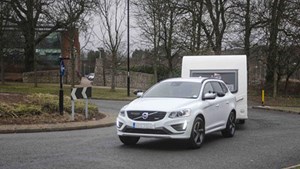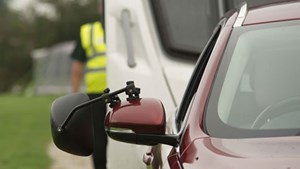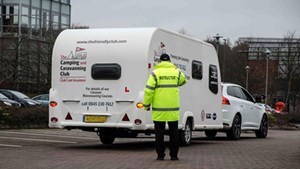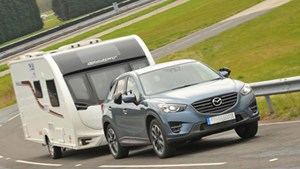How to Tow a Caravan | Beginners Guide to Towing
Towing a caravan for the first time may seem a scary prospect, but it needn’t be. Read up on all you need to know below or attend one of our Club Courses.
If the thought of towing is preventing you from buying a caravan, there are places where you can have a go before you buy a unit.
Some of the larger caravan shows have opportunities to try towing a caravan, under the watchful eye of a professional instructor.
Your local caravan dealer may also be prepared to let you take a caravan on the road – especially if it helps secure a sale.
Before you tow: getting the right driving licence
The standard driving licence issued to a driver passing the test in Great Britain (not Northern Ireland) includes his or her test today covers categories B, B1 and now BE. This means you can drive a vehicle up to 3,500kg (B) and tow a trailer up to 3500kg behind it (E). When you reach your 70th birthday slightly different rules apply if you’d like to keep towing, see our driving licence guide for more information.
On the road
 When you’re towing, you’ll need to give yourself more time and space for everything. Look well ahead so you can predict the movement of other vehicles, brake earlier than normal and you’ll probably accelerate more slowly with a caravan on the back, so you need to anticipate this when pulling out into traffic.
When you’re towing, you’ll need to give yourself more time and space for everything. Look well ahead so you can predict the movement of other vehicles, brake earlier than normal and you’ll probably accelerate more slowly with a caravan on the back, so you need to anticipate this when pulling out into traffic.
The extra length of your outfit means you will need to take corners more widely than normal so the caravan wheels don't clip the kerb or cut the corner.
Remember the legal speed limits are often lower when you’re towing. Don’t exceed 50mph on single carriageways or 60mph on dual carriageways.
You may not tow in the furthest right (‘outside’) lane of a three-or-more lane motorway unless instructed to do so.
 It is a legal requirement to always have a good view to the rear of your unit, which will mean using extension mirrors in the vast majority of combinations. And don’t forget to take them off when you’re not towing. Take a look at our video on how to fit towing mirrors for more tips.
It is a legal requirement to always have a good view to the rear of your unit, which will mean using extension mirrors in the vast majority of combinations. And don’t forget to take them off when you’re not towing. Take a look at our video on how to fit towing mirrors for more tips.
Never carry passengers in the caravan when you’re towing it. It’s theoretically legal to transport animals inside a caravan, but it’s definitely not recommended.
The number plate on the back of your caravan must show your car’s registration number, conform to the relevant British Standard and be illuminated at night. This means no felt-pen on cardboard!
 Your rear light panel must always be working. Remember to check before driving and keep an eye out for anything that changes during your journey. Your car must show that the indicators are working while you are driving. This might be done positively (by a special light flashing or buzzer sounding when the indicators are on) or negatively (by giving a warning if a bulb fails).
Your rear light panel must always be working. Remember to check before driving and keep an eye out for anything that changes during your journey. Your car must show that the indicators are working while you are driving. This might be done positively (by a special light flashing or buzzer sounding when the indicators are on) or negatively (by giving a warning if a bulb fails).
If you find traffic is building up behind you, pull over at a layby or other suitable place when safe to do so and let the other vehicles pass.
Park carefully where you won’t cause an obstruction. Caravans must not be parked in parking meter bays.
Snaking and pitching
 The word ‘snake’ can strike terror into the heart of a prospective caravanner, but with a little care before your journey - and an awareness of what to do if a snake occurs - it shouldn’t prevent you taking to the road.
The word ‘snake’ can strike terror into the heart of a prospective caravanner, but with a little care before your journey - and an awareness of what to do if a snake occurs - it shouldn’t prevent you taking to the road.
Snaking is when the lateral swaying movement (technically known as the ‘yaw’) of the caravan behind a car becomes excessive. In extreme cases, the caravan swings ever more violently from side to side, eventually dragging the back of the car with it so the driver loses control.
‘Pitching’ describes vertical instability – when the caravan’s front end moves up and down, pulling the rear of the car around like a seesaw.
The best way to avoid snaking and pitching is to have a well-matched car and caravan and to load your unit carefully.
Electronic and friction stabilisers are fitted to many caravans, which can reduce these problems in a well-matched outfit, but will not rectify an inherently unstable combination.
But even with all these precautions, you might find the back of your car being pulled by your caravan because of the air turbulence caused by a passing lorry, coach or a crosswind.
If the caravan does start yawing or pitching, take both feet off the pedals to bring down your speed using your car’s engine braking. Avoid the instinct to brake, but keep steering in a straight line. Trying to steer out of the sway can make the problem worse.
Learning to tow your caravan
 We believe everyone would benefit from some professional towing tuition; the Club runs a number of one and two-day courses.
We believe everyone would benefit from some professional towing tuition; the Club runs a number of one and two-day courses.
They will take you through all the basic information you need from hitching up your caravan and car to reversing. We’ll add some important advice on safe caravanning too.
You’ll be taught at the wheel of your own familiar car but towing a special Club caravan, and have the instruction of professional tutors in small groups.
See our video on caravan reversing for some tips.
Find out more about Manoeuvring Courses offered by the Club.
